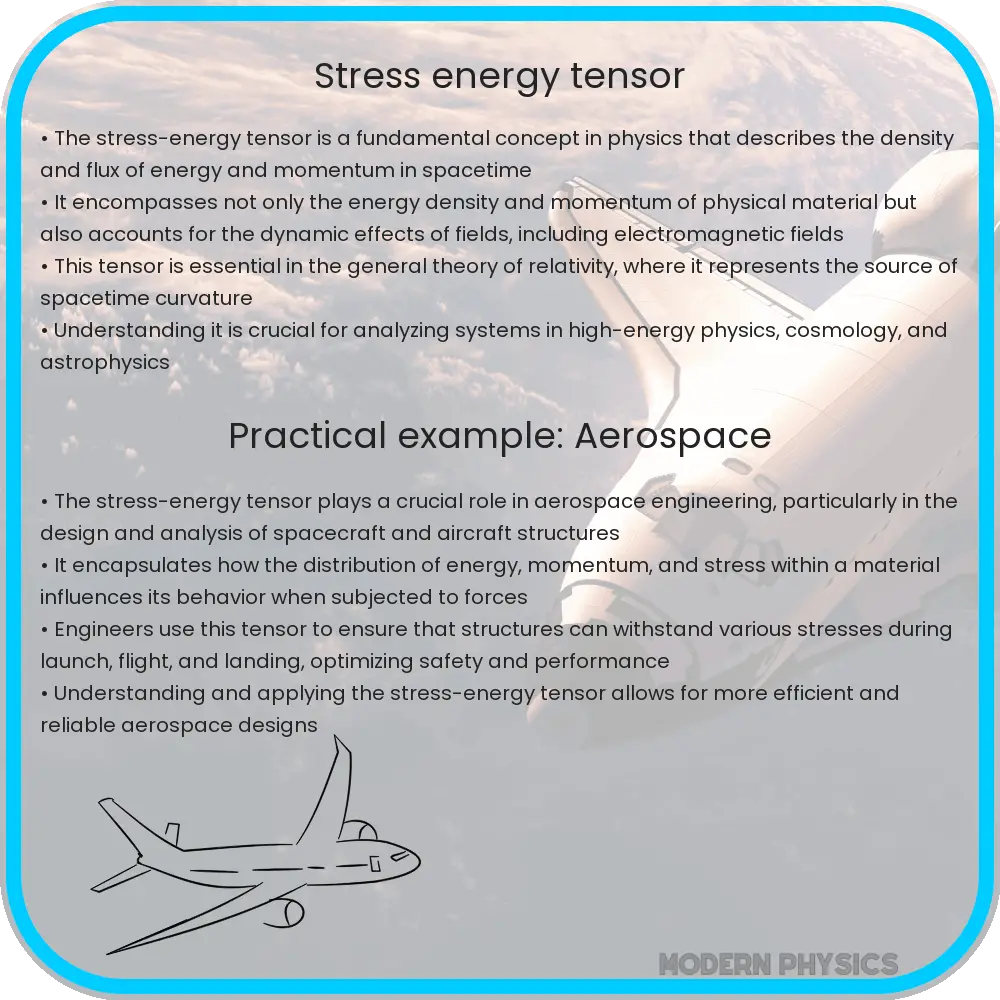Explore the Stress-Energy Tensor, the core of General Relativity, its role in astrophysics, cosmology, and the challenges in modern physics.

Understanding the Stress-Energy Tensor: The Backbone of General Relativity
At the heart of Albert Einstein’s theory of General Relativity (GR) lies a concept pivotal to understanding how matter and energy interact with the fabric of spacetime: the Stress-Energy Tensor (SET). This mathematical construct not only underpins the principles of GR but also provides a comprehensive description of the distribution and flow of energy and momentum in spacetime.
Defining the Stress-Energy Tensor
The Stress-Energy Tensor, denoted by Tμν, is a rank-2 tensor that encapsulates the density and flux of energy and momentum in four-dimensional spacetime. Its components represent various physical quantities:
- Energy Density: T00 gives the energy density, which is the amount of energy per unit volume.
- Momentum Density: The components T0i (where i = 1, 2, 3) represent the momentum density in the three spatial directions.
- Stress: The spatial components Tij describe the internal stresses within a material, akin to pressure and shear stress.
The SET is fundamental in Einstein’s field equations, which form the core of GR. These equations, Gμν = 8πTμν, relate the geometry of spacetime, expressed by the Einstein tensor Gμν, to the energy and momentum within that spacetime, as described by the SET.
Applications and Implications
Understanding the SET is crucial for exploring various astrophysical phenomena and cosmological models. For instance:
- The behavior of stars, black holes, and galaxies is governed by how their mass-energy content distorts spacetime.
- In cosmology, the SET helps in understanding the evolution of the universe, including models of the Big Bang and cosmic inflation.
- It plays a vital role in the study of gravitational waves, as changes in the SET can lead to ripples in the fabric of spacetime.
Moreover, the SET is a cornerstone in the bridge between GR and Quantum Field Theory (QFT). In QFT, the SET becomes an operator rather than a classical field, opening pathways to studying quantum effects in curved spacetime.
In essence, the Stress-Energy Tensor is not just a mathematical abstraction but a tool that enables physicists to decipher the universe’s most profound secrets. From the cosmic dance of galaxies to the quantum realm, its implications span the vast expanse of physical reality.
Challenges and Advances in Understanding the Stress-Energy Tensor
The exploration of the Stress-Energy Tensor (SET) is not without its challenges. One of the primary difficulties lies in its complexity and the need for advanced mathematical tools to accurately describe various physical scenarios. Additionally, integrating the concepts of Quantum Mechanics with General Relativity, especially in extreme conditions like those near black holes or during the early universe, remains a significant theoretical challenge.
Recent Developments and Future Prospects
Recent advances in theoretical physics have shed new light on the SET’s role in understanding the universe. The development of String Theory and Loop Quantum Gravity, for example, offers new perspectives on how spacetime and matter-energy interact at the most fundamental levels. These theories aim to provide a more unified framework that incorporates both quantum mechanics and gravity, potentially offering new insights into the SET’s role in the fabric of the universe.
Experimental advancements, such as more precise measurements of gravitational waves and deeper observations of the cosmic microwave background, also contribute to our understanding of the SET. These observations not only validate the predictions of General Relativity but also provide empirical data to refine our models of the SET in various cosmic scenarios.
Conclusion
The Stress-Energy Tensor remains a central component in our quest to understand the universe. As the key to linking matter, energy, and the geometry of spacetime, it plays a pivotal role in both General Relativity and modern physics. The SET’s complexity and depth make it a topic of ongoing research, challenging and inspiring physicists to delve deeper into the mysteries of the cosmos.
As we stand on the brink of new discoveries in both theoretical and experimental physics, the SET continues to be a crucial tool. It not only helps in deciphering the current state of the universe but also in exploring its past and predicting its future. In essence, the Stress-Energy Tensor is not merely a mathematical construct but a beacon guiding us in our journey through the intricate and fascinating cosmos.
